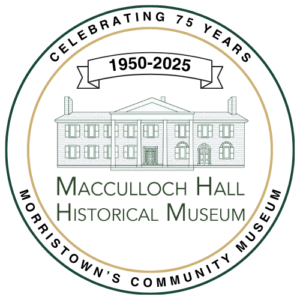In 1860, the United States actively disrupted the trade of enslaved men, women and children from Africa while cultivating a thriving domestic trade of enslaved people. The importation of enslaved people to the United States was outlawed on January 1, 1808. To formally end the domestic trade and enslavement of people in the United States, however, would take the next 4 years of the Civil War (1861-1865) and the adoption of the 13th Amendment on December 6, 1865.
On August 7, 1860 Lieutenant Henry W. Miller, grandson of George Macculloch, and Lieutenant Henry D. Todd, uncle of MHHM founder W. Parsons Todd, were on board the USS Mohican patrolling for slave traders near the mouth of the Congo River. USS Mohican was part of the U.S. Navy’s African Squadron. 50 miles up the Congo River nearly 900 African men, women and children were being forced on board the slaver Erie. Erie’s mission originated in the port of New York City, where it is estimated that at least two ships a month left for the West African coast as part of the trade of enslaved people to Cuba.
160 years ago, on August 8, 1860, the Erie entered the open waters of the Atlantic Ocean and was spotted by the USS Mohican. Erie was under the command of Captain Nathaniel Gordon, an experienced trader of enslaved people, whose father had also engaged in human trafficking. As the USS Mohican approached the Erie, Captain Gordon reached for forged documents and several nations’ flags that could prevent his ship from being boarded and searched. The USS Mohican was a new vessel, however, which prevented Captain Gordon from knowing which country the ship represented. At that decisive moment, Captain Gordon took a chance and hoisted the wrong nation’s flag. Lieutenant Henry Todd boarded the Erie and realized instantly that the Erie was a slaver. The nearly 900 people held captive in the ship’s hold were on their way to lives of enslavement in Cuba.
On August 8, 1860, the USS Mohican rescued nearly 900 people. On the same day, a second slaver, the Storm King, which held 600 kidnapped African men, women and children on board, was also stopped en route to Cuba. This makes August 8, 1860 the day the largest number of kidnapped African men, women and children were freed by the U.S. Navy in United States history.
Resources:
The U.S. Navy brought the kidnapped people to Liberia, a 15-day journey from the Congo River. Captain Nathaniel Gordon was arrested and after two trials was sentenced by Judge William Shipman on November 30, 1861. Gordon was hanged for being a slave trader on February 21, 1862. Gordon is the only person in United States history to be executed for the crime of trafficking enslaved people. President Lincoln refused a pardon to Captain Gordon, giving him a short reprieve to prepare for his execution.
At Gordon’s sentencing, Judge Shipman spoke:
“Do not attempt to hide its enormity from yourself; think of the cruelty and wickedness of seizing nearly a thousand fellow beings, who never did you harm, and thrusting them beneath the decks of a small ship, beneath a burning tropical sun, to die in of disease and suffocation, or be transported to distant lands, and be consigned, they and their posterity, to a fate far more cruel than death…Remember that you showed mercy to none, carrying off as you did not only those of your own sex, but women and helpless children. Do not flatter yourself that because they belonged to a different race from yourself, your guilt is therefore lessened—rather fear that it is increased… As you are soon to pass into the presence of that God of the black man as well as the white man, who is no respecter of persons, do not indulge for a moment the thought that he hears with indifference the cry of the humblest of his children.”
Resources:
Read about President Lincoln on the case of Captain Nathaniel Gordon.
Read an article from Harper’s Weekly, published on March 8, 1862, on the execution on Captain Nathaniel Gordon.
Listen to Ron Soodalter speak about his research and book, Hanging Captain Gordon: The Life and Trial of an American Slave Trader.
Topic: History
Age / Level: High School, College

